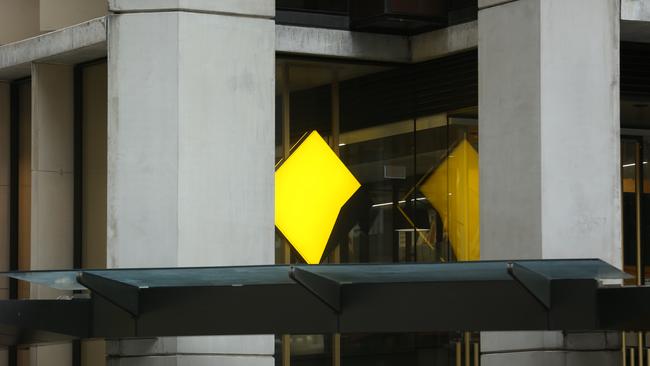Commonwealth Bank reveals $5.13bn cash profit
Australia’s biggest, and most expensive bank, has topped expectations for its first-half profit, revealing a rising lending margin despite flat interest rates.

Young Australians and Victorians are the hardest pressed among Commonwealth Banks’ legion of customers, with the banking heavyweight revealing despite a sagging economy its cash earnings lifted to $5.13bn.
Ruling off its results to December 31, CBA revealed the consensus beating result, which topped expectations of a $5.056bn cash profit.
The 2 per cent lift in cash earnings for the first half of the financial year, was boosted by a rising margin on CBA’s lending operations despite a flat interest rate environment and slowing economy.
CBA is also riding high on low rates of arrears and non-performing loans, with loan losses down 23 per cent on the levels reported by the bank at the same time last year.
CBA chief executive Matt Comyn told The Australian it was obvious from the bank’s data that young savers remain stretched, with 24-35 year olds the only demographic tracked by the bank which hasn’t seen a bounce-back in their saving.
He said it was the higher cost of food and essentials, coupled with surging rents, which had squeezed young customers.
“Our younger customers have less financial resilience,” he said.
“The savings picture is slightly more positive but also reflective where you started many households are still under real pressure.”
CBA’s troublesome and non-performing assets were down over the half, to 0.95 per cent of the balance sheet.
But arrears did lift in the period, just above CBA’s historical average, to 0.66 per cent of the bank’s total loan book.
Victoria is CBA’s most troubled state, representing almost 48 per cent of the bank’s total non-performing, not well-secured home loans.
That’s compared to NSW, which accounts for just 26 per cent of the bank’s troubled book of bad loans.
Mr Comyn said despite the challenging period, the bank was still focused on supporting customers.
“This enables us to support our customers, while lending to productive parts of the economy to stimulate economic growth,” he said.
The broader banking system is wary of intervention by the corporate regulator around hardships, after the Australian Securities & Investments Commission took aim at National Australia Bank and Westpac last year.
Citi analyst Brendan Sproules noted CBA’s asset quality trends which “somewhat painted a picture of a strengthening household”.
“Asset quality and loan growth were the key positives, but management indicated both will moderate as the economy slows,” he said.
Mortgage lending
But CBA’s accounts show the bank — Australia’s largest mortgage lender — is increasingly tilting towards housing investors, who now account for 42 per cent of all new home lending, up 5 per cent from 2023 levels.
Investors have also marched up CBA’s ranks to hit 30 per cent of total lending, up from 29 per cent in June last year.
Owner occupiers as a proportion of CBA’s total loan book have dropped 1 per cent to 69 per cent of the total bank lending.
Mr Comyn said the lift in investor lending reflected the run up in interest rates alongside a rise in house prices which had shut many first home buyers out of the market.
“I think it’s incredibly important to support young Australians in the housing market,” he said.
“We’ve got a long term challenge making sure there’s more affordable housing.”
CBA declared an interim dividend of $2.25 a share, fully franked, topping analyst expectations of a $2.22 dividend. This sees CBA pay out 73 per cent of its cash earnings.

CBA declared a 3 per cent lift in total income over the past year, hitting $14.09bn for the six months to December 31.
Analysts had dialled in expectations CBA would reveal its revenues had hit $13.98bn.
CBA reported a 2.08 per cent net interest margin, the core measure of the bank’s lending profitability. This was up 1 basis point on the levels reported by the bank in its 2024 second half earnings and up 2 basis points from the same time last financial year.
Interest rates
Mr Comyn said CBA was witnessing a slowing economy, with cost pressures weighing on consumer spending and younger customers alike.
“Private sector growth is weak, immigration is starting to slow, and geopolitical uncertainties remain,” he said.
“However, underlying inflation is now moderating towards the target range, and we expect Australia will follow offshore economies with an easing cycle starting in 2025.”
The Reserve Bank is set to hand down its interest rate decision on February 18, in the wake of recent news that inflation growth has sagged to a 2.4 per cent over 12 months.
Mr Comyn said if the RBA didn’t cut rates Australians would be “disappointed”.
But he noted the RBA should act independently on “what they determine to be the appropriate path”.

In total, CBA spent $6.37bn on staff and operational costs, with the bank’s big investments in Generative AI also driving costs.
CBA reported a rise in its expenses, up 6 per cent of the bank’s first-half result last year.
Investment spend was up 11 per cent in the half, hitting $1.1bn.
The results come amid analyst hopes CBA would look to hand back more cash to investors amid a sluggish $1bn buyback.
Only around $300m of CBA’s shares have been repurchased by the bank since the handout was kicked off in August last year.
CBA has ploughed cash into buybacks in recent years, including sealing a $6bn program in 2021.
Morgan Stanley had even forecast CBA could look to buy a further $1.5bn in shares.
CBA shares have been a major winner in the last year, lifting 40.12 per cent over 12 months.
But analysts at investment house VanEck had warned CBA’s result would unravel the bank’s “Cinderella story”.
VanEck’s senior portfolio manager Cameron McCormack said CBA’s share price, now among the most expensive banks in the world, had defied gravity.
Despite stagnant earnings growth, it’s currently trading at an all-time high of 27 times the 12-month forward earnings, which is higher than the growth-oriented S&P 500,” he said.
Shares in CBA fell 0.86 per cent on open to $160.72 by 10.30am, close to their record high of $162.64.
More Coverage
Originally published as Commonwealth Bank reveals $5.13bn cash profit





